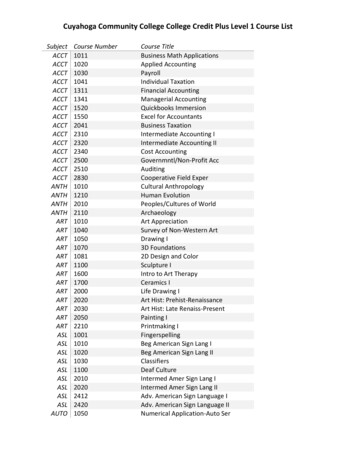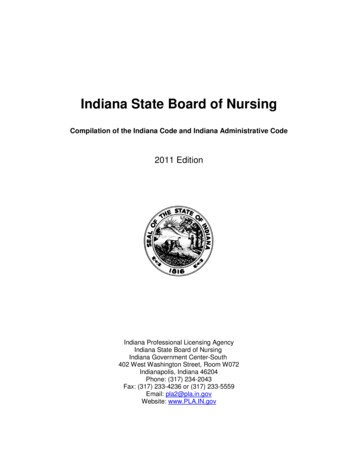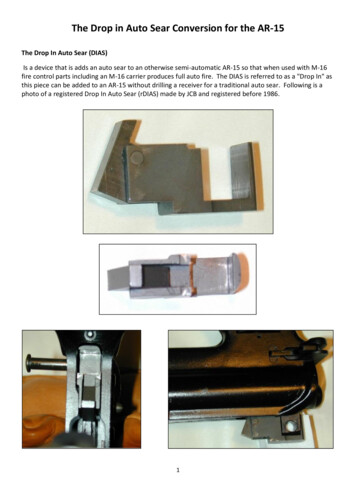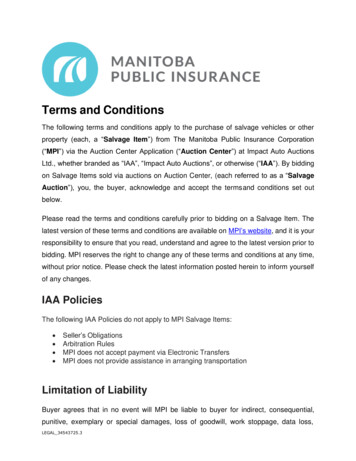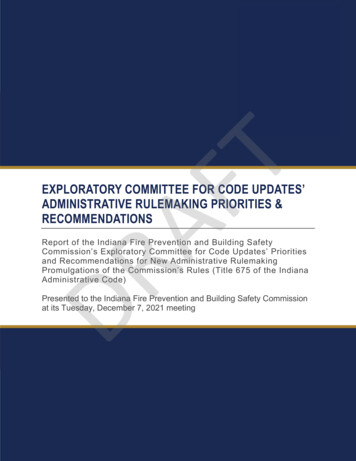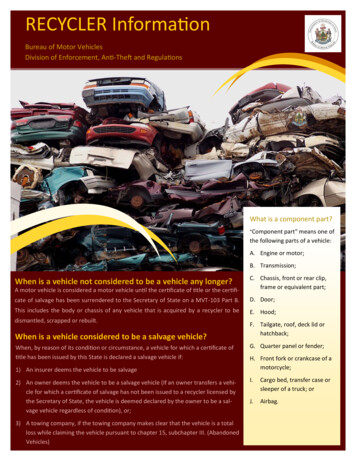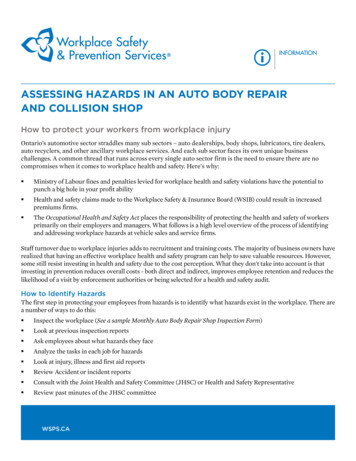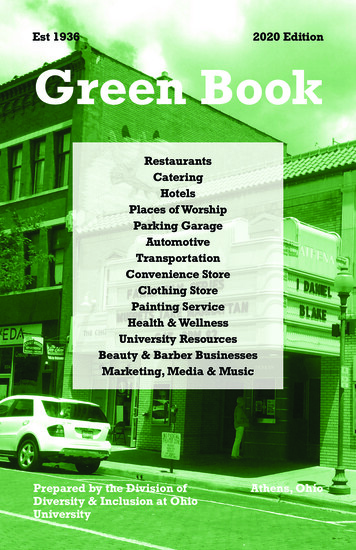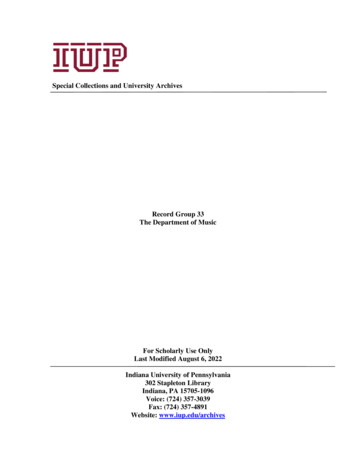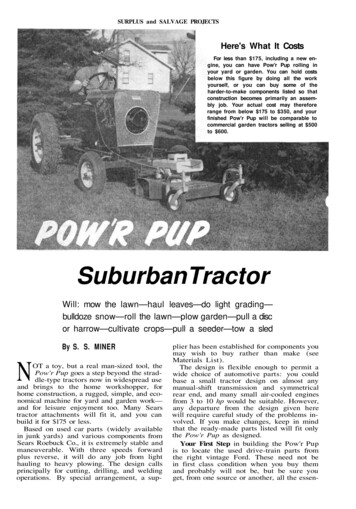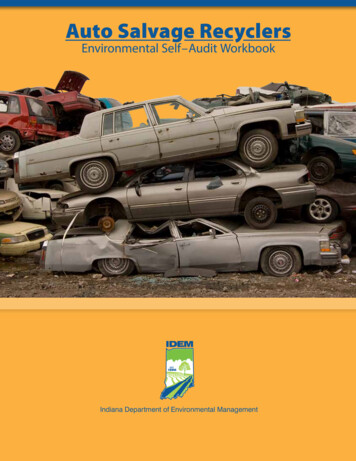
Transcription
Auto Salvage RecyclersEnvironmental Self–Audit WorkbookIndiana Department of Environmental ManagementAUTO SALVAGE RECYCLERS PROGRAM1
Auto Salvage RecyclersEnvironmental Self-Audit WorkbookPrepared byIndiana Department of Environmental ManagementOffice of Land QualityIndustrial Waste Compliance100 North Senate AvenueIndianapolis IN ted January 2017AUTO SALVAGE RECYCLERS PROGRAM3
ACKNOWLEDGEMENTSThe Indiana Department of Environmental Management (IDEM) acknowledges the followingorganizations for their contributions to the development of this workbook.Indiana Auto Salvage Recycler’s AssociationPull-A-Part Used Auto PartsSummit, Inc.AutoZoneCar X Muffler and BrakesIndiana State Department of HealthMarion County Health DepartmentIndiana Secretary of State — Dealer/Special Sales DivisionU.S. Environmental Protection Agency (U.S. EPA)Indiana Department of Environmental ManagementOffice of Water Quality (OWQ) — Wetlands and Storm WaterOWQ — Drinking WaterOWQ — Ground WaterOffice of Air Quality — ComplianceOffice of Land Quality (OLQ) — Emergency ResponseOLQ — Industrial Waste ComplianceOffice of Program Support — Assistance and Outreach BranchDisclaimer:The Indiana Department of Environmental Management does not endorse or recommendany product, company, or organization identified or depicted in this document.4WWW.IDEM.IN.GOV
TABLE OF CONTENTSIntroduction6Instructions7Section A: Auto Salvage License8Section B: Fluids Management9Section C: Oil16Section D: Underground Storage Tanks20Section E: Hazardous Waste Management21Section F: Waste Tire Management22Section G: Mercury Switches26Section H: Solid Waste Management31Section I: Air33Section J: Water38Telephone Numbers52Web Sites with Additional Information53Record Keeping Forms54Annual Mercury Safety TrainingRefrigerant Removal RecordsVehicles Obtained Without RefrigerantsGood Housekeeping Inspection ChecklistBest Management Practices for WaterQuarterly Storm Water Visual MonitoringAnnual Storm Water Pollution Prevention Plan TrainingAUTO SALVAGE RECYCLERS PROGRAM5
INTRODUCTIONThe auto salvage recycling business sector is over seventy-five years old. It has evolved into asophisticated, technology-driven operation that constantly changes in response to innovationsin the automotive industry. To be competitive and profitable in today’s markets, the autosalvage recycling process must involve more than merely crushing wrecked, abandoned, andworn-out motor vehicles. The modern-day auto salvage recycler needs established operatingpractices that realize the maximum market value of every end-of-life vehicle, as well asproviding environmental protection within the community.This workbook provides information that the auto salvage recycler needs in this modern age.Utilizing this information will help you better understand the environmental issues, complywith state and federal environmental regulations, and implement best management practices(BMPs) to minimize risks and liabilities. If you discover environmental violations at yourbusiness, this workbook can help you return to compliance without enforcement penalty.Use of this workbook is voluntary. However, it will help you identify any issues and prepareyour facility in the event of an inspection. You should keep copies of your checklists and anyother forms you submit in order to assist you in demonstrating compliance with applicablestate and federal regulations.If you would like free, confidential, environmental assistance with your business, you can callIDEM’s Compliance and Technical Assistance Program (CTAP). CTAP staff are available weekdaysto answer your environmental questions regarding air, water, and waste regulations, pollutionprevention, and recycling. You can call CTAP at (800) 988-7901 or (317) 232-8172.Clean Yard ProgramThe Indiana Clean Yard program recognizes auto salvage recyclers who make sure that theenvironment and their communities are protected from pollution. There are two levels ofrecognition: Indiana Clean Yard, and Indiana Clean Yard Gold Level.The first step to become an Indiana Clean Yard is for the owner or operator to conduct aself-audit of the facility using this workbook, and fix any issues found. Then, the owner oroperator can submit the Auto Salvage Recyclers Certification Program EnvironmentalSelf-Audit Checklist and Certification Statement (both available on the www.in.gov/idem/5157.htm, IDEM Forms page). IDEM will review the forms and schedule a site visit to verify that yourfacility follows environmental regulations, has necessary licenses and approvals, and has aneffective recycling program. If IDEM finds no issues during the review and site visit, we willpresent you with the Indiana Clean Yard Award. For more information about the Indiana CleanYard Program, call IDEM at (317) 232-8172 or (317) 234-6951. You can also visit the IDEM CleanYard Website at GOV
INSTRUCTIONSIDEM created this workbook to help you, the auto salvage recycler, understandthe environmental regulations that apply to your business.You can use this workbook to conduct an inspection of your facility and correctany potential violations that you find.This workbook is divided into multiple sections labeled A through J and eachsection addresses a different compliance topic. For example, Section A: AutoSalvage License explains who needs to have an auto salvage license and whatto do if you need a license.There are two types of questions in this workbook. Questions followed by anexplanation in an orange box like this:The workbook sections also include information and resources to helpyou manage your business’s environmental needs while utilizing bestmanagement practices (BMPs). Information placed in orange boxessimilar to this refers to BMPs. While not required by regulation,BMPs will help you run your business in a more cost effective andenvironmentally-safe manner.These questions are about best management practices (BMPs) which are voluntary.All other questions are about regulations; these regulations are mandatory andmust be followed. For example, see question 1 in A: Auto Salvage License.We also created the Auto Salvage Recyclers Certification Program EnvironmentalSelf-Audit Checklist form (SF 53765) to help document and evaluate yourcompliance. This form can be found at http://www.in.gov/idem/5157.htm. Youdo not need to mail this form to IDEM unless you plan on becoming an IndianaClean Yard.If you have questions about this workbook, contact IDEM’s Industrial WasteCompliance Section at (800) 451-6027 or (317) 234-6951.AUTO SALVAGE RECYCLERS PROGRAM7
A: AUTO SALVAGE LICENSEIn addition to following environmental regulations, youalso need to make sure that your salvage recycling yardis licensed by the Indiana Bureau of Motor Vehicles.Do you have a valid Indiana Automotive1 Salvage Recycler Business License?An auto salvage recycler facility.A copy of the license applicationform can be found at www.idem.IN.gov/sos/dealer/2383.htmSample salvage motor vehiclebusiness license8WWW.IDEM.IN.GOVA license is required for disposal facilities, used partsdealers, or automotive salvage rebuilders that do anyof the following activities:Sell a used major component part of a vehicle;Wreck or dismantle a vehicle for resale of themajor component parts of the vehicle;Rebuild a wrecked vehicle or dismantled vehicle;Possess more than two (2) inoperable vehiclessubject to registration for more than 30 days; and,Engage in the business of storing, disposing,salvaging, or recycling of vehicles, vehiclehulks, or the parts of vehicles.If you do not have a valid (i.e., current) Indiana SalvageRecycler Business License, you will need to get one.To be in compliance, you will need to complete thelicense application form and submit the form with theapplication fee to:Secretary of State of Indiana Dealer Division302 W. Washington Street,Room E018Indianapolis, Indiana 46204
B: FLUIDS MANAGEMENTAs the operator of an auto salvage recycling business,you work with numerous types of fluids, and youneed to be aware that many of them can pose a threatto human health and the environment if not handledcorrectly. Fluids are generally best managed by startingthe fluids management process as soon as you receive avehicle and diligently following through with all of therecommendations you will find here. This section willexplain some requirements and suggestions for helpingmanage your fluids in the best way possible.Fluid pooling beneath stored vehicles.Do you have spills or releases of fluids1 at your facility?Fluids can include gasoline, fuel, motor oil, antifreeze,transmission fluid, brake fluid, battery acid, powersteering fluid, crank case oil, solvents, paints, etc.To be in compliance, you will need to immediatelyclean-up, remove, and contain all spills and contaminatedsoil/debris resulting from spills and releases.If the visible contamination is less than twelve (12)inches below the ground surface, then remove atleast six (6) inches of soil/debris below the visiblecontamination. Dispose of all waste and contaminatedsoil/debris in a state permitted municipal solid wastelandfill. Submit to IDEM, documentation of properdisposal of the remediated waste, as well as, plans toprevent future contamination (e.g., photos, receipts).Be aware that if the spilled material is unknown, youwill need to conduct a waste determination prior todisposal of your contaminated material. See the orangebox at the right for guidance information.Release of fluids from above ground storagetanks in poor condition with no label.For guidance in making a wastedetermination, visit www.idem.IN.gov//landquality/files/hw waste info determinationprocess.pdf www.idem.IN.gov/ctapor call IDEM toll free at(800) 988-7901 or (317) 232-8172.If the visible contamination is greater than twelve(12) inches below the ground surface, notify IDEM todetermine the necessary clean-up requirements. CallIDEM’s Office of Land Quality — Industrial WasteSection at (800) 451-6027 or (317) 234-6951.AUTO SALVAGE RECYCLERS PROGRAM9
FLUIDS MANAGEMENTIf you answered “YES” to the question1a above, did you report the spill(s) andrelease(s) to IDEM upon discovery?In the future, you will need to call IDEM’s Officeof Land Quality – Emergency Response Section at(888) 233-7745 or (317) 234-4112 to report anyspill or release.Do you remove fluids and filters fromRemoval of fluids prior to storingthe vehicle.Oil removed and drained from oil filters.Fluid removal prior to storing carsin the yard can greatly reduce fluidsreleases to ground and storm water.Some fluids can be recycled or reusedafter removal.10WWW.IDEM.IN.GOV2 vehicles prior to storing them in your yard?It is recommended that you remove all fluids andfilters from vehicles before you store them in the yard.Removing these helps prevent potential health andenvironmental hazards. Used automotive fluids cancontain contaminants, such as solvents, which cancause negative health effects as mild as nausea oras severe as life-threatening organ damage. Evenclean, new fluids can pose a health risk: gasolinecontains benzene, a chemical known to cause cancer.Additionally, removing the fluids and filters allowsyou to recycle them.
FLUIDS MANAGEMENTyou remove batteries from vehicles3 Doprior to storing them in your yard?It is suggested that you remove batteries from vehiclesprior to storing the vehicles in your yard, since theycontain harmful substances such as lead, zinc, mercury,nickel, cadmium, and strong acids. A substance withthe corrosive ability of a strong acid or the toxicpotentials of lead, zinc, mercury, nickel, and cadmiumshould not be released to the environment. By removingbatteries, you help ensure that these contaminants stayout of our soil, water and air.Proper battery storage inside a trailer.Do you store vehicle batteries in a4 building or away from the elements(e.g., rain and snow) to prevent a releaseinto the environment?Once you have taken the first step of removingbatteries, the next thing to do is store them properly.The best possible way to store batteries is in containersor structures that can catch any leaks. These containersor structures are also known as secondary containmentunits. Containers should then be kept inside a building.By following this suggestion, you decrease thelikelihood that contaminants (acid, lead, etc.) fromthe batteries will leak onto the ground or be washedinto waterways by rain or snow. Storing batteries insecondary containment inside a building also helpslessen the chances of a potentially costly clean-up inthe event of an accidental release.Proper battery storage inside a buildingin secondary containment.Batteries stored inside withsecondary containment.AUTO SALVAGE RECYCLERS PROGRAM11
FLUIDS MANAGEMENTyou crush vehicles on site?5 DoThis applies to a crusher that is owned orcontracted by the facility to do work on site.If “NO”, skip question 5a.If you answered “YES” to the question5a above, is the crusher located in animpervious secondary containment unitor inside a building with concrete floors?Auto recycler crushing operation.After you have removed all automotive fluids, residualfluids will undoubtedly remain. In order to decreasethe chance that these fluids will spill onto the groundduring crushing and contaminate the environment, youshould consider placing the crusher in an impervioussecondary containment unit or inside a building withimpervious concrete floors.Do you remove and recycle windshield6 wiper fluid?Crusher placed in secondary containment.Windshield wiper fluid storage.12WWW.IDEM.IN.GOVMost people are familiar with the idea that gasolineand oils can cause health and environmental damage.However, many people do not realize that windshieldwiper fluid, because of constituents like ethyleneglycol, can also negatively impact human health andthe environment. By removing windshield wiper fluid,you will be helping to ensure this contaminant does notreach the environment, and possibly save money.
FLUIDS MANAGEMENTDo you inspect all fluid containers weekly7 for rust, dents, holes, bulges and leaks?You should inspect all your fluid containers on aweekly basis for rust, dents, holes, bulges and leaks.By doing this, you will notice any problems andtherefore decrease the possibility of an accidentalrelease which could cause damage to the environmentor loss of recyclable materials.Do all of your fluid containers have secure8 (tightly-sealed) lids?Drums that are rusted and dented.You should secure the lids on all of your fluidcontainers. Following this suggestion will lessen thechances that contaminants will reach the environmentthrough evaporation or accidental spills. This will alsohelp prevent contamination of your usable fluids.Properly closed parts washer.Properly closed parts washer.AUTO SALVAGE RECYCLERS PROGRAM13
FLUIDS MANAGEMENTyou label all of your fluid containers to9 Doidentify the contents?Properly labeled and stored antifreeze.Labeling all of your fluid containers is an easysuggestion to follow. This will help prevent accidentalmixing of incompatible substances. Also, it is mucheasier for you to know how to react to a spill if youknow what fluid has spilled. This also helps whenemergency responders need to come to your facilityregarding a spill. Labeling fluids can also help withrecycling and avoid the potential costs of a wastedetermination, a procedure that sometimes must be donein order to determine the identity of an unknown material.Do you store your fluid containers in a10 building or away from the elements(e.g., rain and snow) to prevent releasesto the environment?Properly labeled and stored fluids.Properly labeled and stored fluids instationary secondary containment.14WWW.IDEM.IN.GOVStoring fluid containers in a building or away from theelements is another suggestion you can follow to helpensure that fluids do not reach the environment. Youcan also add secondary containment pads for increasedprotection. These measures will help lessen the chancesof a potentially costly clean-up in the event of anaccidental release.
FLUIDS MANAGEMENTDo you store empty drums in a manner11 that prevents the accumulation of rainwater?Keep empty drums in a manner that preventsthe accumulation of water. For example, you canstore them capped and laid on their sides. This willhelp prevent the accumulation of stagnant water, whichcould serve as a mosquito breeding ground. This alsohelps ensure that no water will come into contact withresidual fluids and wash them into the soil or water.Open containers collecting rainwater.Do you store engines, transmissions, and12 other vehicle parts in a building or awayfrom the elements (e.g., rain and snow)to prevent releases to the environment?Store vehicle parts inside a building. By storing themoutside, you risk potential contamination if residualfluids leak out, or if precipitation washes the fluids intothe environment. Inside storage will lessen the chancesof contamination, and your parts will be protected fromdamage by the elements.Drums capped and stored on their sides.Are your floor drains closed or filled in13 where fluids are present?If you have floor drains in an area where fluids arepresent, we suggest that you close or fill in the drains.By doing so, you make clean-up easier and you helpensure that your fluids will not find their way into thesoil or water if they happen to spill on your floor.Parts stored in racks inside building.Filled in floor drain.AUTO SALVAGE RECYCLERS PROGRAM15
C: OILImproperly stored used oil.Oil, especially used oil, has the potential to causepollution and other negative effects if handledincorrectly. Used oil is also one of the most commonwaste fluids you generate at your facility. Becausesalvage yards so commonly deal with this fluid, theimportance of following all applicable regulations cansometimes get lost in the shuffle of everyday business.This section will help you understand some of the mostcommon regulations that apply to storage, use anddisposal of used oil.Are your oil containers and/or tanks in1 good condition?Labeled drum of used oil.Good condition is free from rust, dents, holes, bulgesand leaks. Inspect all used oil storage containers and/or tanks at your facility. To be in compliance, youwill need to immediately replace/repair any damagedcontainers and/or tanks. Dispose of deterioratedcontainers at an approved disposal or recycling facility,as appropriate. Maintain containers and/or tanks ingood condition.Do you label used oil containers and/or2 tanks with the words “Used Oil”?Used oil label.16WWW.IDEM.IN.GOVAll containers and/or tanks that store used oil must belabeled clearly with the words “Used Oil”. No otherphrases are acceptable. If your containers and/or tanksare not labeled with the words “Used Oil”, you willneed to label them. In addition to tanks and containers,label any fill ports if the fill ports are not directlyassociated with the containers and/or tanks.
OILAn example of this is when a container and/or tankis outside the building and the fill port (commonly asink or pump) is located inside the building. To be incompliance, you will need to label (e.g., via stickers,paint, marker, stenciling) all of your used oilcontainers and/or tanks with the words “Used Oil”.3Do you burn used oil in a space heater?If “NO”, skip question 3a.The use of an oil-fired space heater is permittedprovided that the heater has a maximum capacity ofno more than a half (0.5) million BTUs/hour and thatthe combustion gases from the heater are vented tothe ambient air.Used oil storage tank insecondary containment.Do you burn used oil generated only3a by your facility or by a householddo-it-yourselfer?If you burn oil generated by another facility (exceptfor household do-it-yourselfers), you will need toimmediately cease the use/acceptance of used oilgenerated at other locations.If you would like to continue to use/accept used oilgenerated by another location, you must comply with329 IAC 13-4-1 requirements for used oil marketers.Space heater with labeledused oil storage tank.If you have any questionsabout the rule for burningused oil, please contact IDEM’sOffice of Land Quality toll freeat (800) 451-6027 ext. 234-6935.AUTO SALVAGE RECYCLERS PROGRAM17
OILyou use a registered transporter for4 Doyour shipments of used oil?If “YES”, skip question 4a.You can find a list of registered used oil handlersatwww.idem.IN.gov/landquality/2371.htmDo you transport used oil (fifty-five4a (55) gallons or less) in a company (orRegistered used oil transporter.employee) vehicle to one of thefollowing locations:a government approved collectioncenter; or,an aggregation point owned oroperated by your company?ORDo you have a contract that requires yourused oil to be returned to you for re-use?Drum transported in a truck bed.18WWW.IDEM.IN.GOVYou may self-transport fifty-five (55) gallons or less ofused oil if you take it to an approved collection centeror company owned aggregation point. If you do nottake your oil to an approved location or have anapproved contract, you will need to immediatelycontract the services of a registered transporter andmaintain records of shipments or you may self-transportto an approved location.
OILDo you have a total on site storage5 capacity for oil and other petroleumproducts that exceeds one thousandthree hundred and twenty (1320) gallons?Capacity equals the amount the containers and tankscan hold, NOT the amount of oil and other petroleumproducts you currently have.If “NO”, skip question 5a.Oil storage capacity exceeding 1320 gallons.Calculate the oil and other petroleum products storagecapacity you have on site. This will include all oil andother petroleum products, both new and used. The onlycontainers that you will need to count are those aboveground with a capacity to hold fifty-five (55) gallonsor more. If the total capacity is less than one thousandthree hundred and twenty (1320) gallons, answer NOand skip question 5a.Does your facility have a Spill Prevention,5a Control, and Countermeasure (SPCC) Plan?Oil storage capacity exceeding 1320 gallons.If your facility does not have an SPCC Plan, you willneed to develop an SPCC Plan. Or, you may reduce thetotal on site oil and other petroleum product capacityat your facility.For more information on developing an SPCC plan,visit www.epa.gov/oem/content/spcc/index.htmor call the U.S. EPA at (312) 866-9497.Sample spill prevention control andcountermeasures plan cover page.AUTO SALVAGE RECYCLERS PROGRAM19
D: UNDERGROUND STORAGE TANKSThe presence of an underground storage tank (UST),whether in use or out of service, could mean that yourfacility is subject to additional regulations. It’s possiblethat you have an underground storage tank, but are notaware of it. If you have items resembling those depictedto the left, you will need to examine them further todetermine if you do have a UST.Remnants of a dispenser pad for a UST.1Does your facility have any USTs?If “NO”, skip question 1a.1a Do you have petroleum or hazardoussubstance-containing UST(s) (onehundred ten (110) gallons or more) thathave not been registered with IDEM?Note: USTs storing fuel for heating are exempt.Vent lines for a UST.Fill pad for a UST.For a registration application,visit www.idem.IN.gov/5157.htm#olq auto20WWW.IDEM.IN.GOVIf you have a UST(s) that has not been registered withIDEM, you will need to contact IDEM’s Office of LandQuality — Underground Storage Tank Section toll freeat (800) 451-6027 ext. 234-0343 to register or closeyour tank.
E: HAZARDOUS WASTE MANAGEMENTSome small businesses, including salvage yards,are hazardous waste generators. Even if you onlygenerate a small amount of hazardous waste, it’s stillimportant to handle the waste properly. Some of theitems that an auto salvage business may have that couldbe considered hazardous waste are: solvents, paints,aerosol cans, rags contaminated with solvents or paints,lead acid batteries, and fluorescent lights.Does your facility have any unknown1 materials on site?If you have unknown materials, you will need to identify(e.g., conduct a waste determination) the unknownmaterials and determine if they are hazardous.Unlabeled group of drums withunknown contents.Do you generate hazardous waste in2 quantities greater than or equal to twohundred twenty (220) pounds per month?If you generate hazardous waste in quantities greaterthan or equal to two hundred twenty (220) poundsper month, you will need to contact IDEM’s Officeof Land Quality — Hazardous Waste Section toll freeat (800) 451-6027 or (317) 234-6951 to obtain a U.S.EPA ID number and for further guidance on how toproperly manage the waste.A half full 55 gallon drum is about220 pounds.For guidance in making a wastedetermination, visit www.idem.IN.gov/landquality/files/hw waste info determinationprocess.pdf www.idem.IN.gov/ctapor call IDEM toll free at(800) 988-7901 or (317) 232-8172.AUTO SALVAGE RECYCLERS PROGRAM21
F: WASTE TIRE MANAGEMENTWaste tires can pose a fire hazard and provide breedinggrounds for rodents and mosquitoes. In order to reducethese potential hazards, it’s important for you to complywith Indiana’s waste tire regulations. The informationbelow can help you determine what problems you mayhave and also provide you with information on how toremedy some of those problems.Does your facility have over 1,000 waste2/32 inch tread depth test with a penny.1 tires stored outside or over 2,000 wastetires stored inside?If “NO”, skip question 1a.A waste tire is a tire that is not suitable for the tire’soriginal purpose. A tire with less than two-thirtyseconds (2/32”) of an inch tread is considered to bea waste tire. To test tread depth, place a penny intoseveral tread grooves across the tire. If part of Lincoln’shead is always covered by the tread, you have morethan two-thirty seconds (2/32”) of an inch of treaddepth remaining.Does your facility have a valid1a certificate of registration as a wastetire storage facility?Sample waste tire storage registration.22WWW.IDEM.IN.GOVIf your facility does not have a valid waste tire storageregistration, you will need to obtain one.
WASTE TIRE MANAGEMENTDo you open dump waste tires at2 your facility?If you have uncovered and/or unaltered waste tireskept outside, you likely have an open dump, and willneed to collect and remove all waste tires presentlyon site and haul them to a state approved waste tiremanagement facility. Be advised that IC 13-20-14-1prohibits the disposal of whole waste tires at Indianasolid waste landfills. The Indiana Air Pollution ControlRule prohibits the open burning of this waste. Or youmay keep waste tires in an enclosed area or coveredcontainer until you dispose of the waste tires.Open dump of tires.Do you store waste tires in a manner3 that poses a fire hazard?If you store your waste tires in a manner that poses afire hazard (e.g., near heat sources and activities likewelding, torching, smoking or under power lines) youwill need to change this practice. To be in compliance,you will need to store waste tires away from potentialfire hazards.Tire fire due to storing tires in anunsafe manner.For more information onstoring tires in a manner thatdoes not pose a fire hazard,you can contact theIndiana State Fire Marshal at(317) 232-2222.AUTO SALVAGE RECYCLERS PROGRAM23
WASTE TIRE MANAGEMENTDo you prevent water from accumulating4 in the waste tires?Water accumulation in waste tires is not allowed.If you do not prevent water from accumulating in yourwaste tires, you will need to do so by cutting or drillingholes, and/or by storing in a building, under a tarp, inan enclosed area or in a covered container.Tires stored improperly in standing water.Do your waste tires have the potential5 to harbor vectors that pose a threat tohuman health?A vector is a mosquito or other animal that can carrydisease to humans.Mosquito larvae in tire.(Marion County Department of Health)Mosquito larvae.(Indiana State Department of Health)24WWW.IDEM.IN.GOVIf your waste tires have the potential to harbor vectors,you will need to manage waste tires in a manner thatminimizes vector attractions by cutting tires, drillingholes in tires, storing tires in a building, and/or storingtires in enclosed areas or covered containers. In extremecases, you will also need to ensure removal of vectors(e.g., spraying for mosquitoes).
WASTE TIRE MANAGEMENT6Do you ship whole waste tires off-site?If “NO”, skip question 7.Are your tires delivered to one or more7 of the approved locations:a wholesaler or agent of a wholesaler;a facility that manufactures or retreads tires;Shredded waste tires.a permitted final disposal facility regulatedunder environmental management laws;a permitted waste tire storage site;a permitted waste tire processor; ora registered waste tire transporter.If your tires are not taken to an approved location,you will need to immediately cease transport to allunapproved facilities. Begin transporting all wholewaste tires to an approved facility. Keep proof oftransport to an approved facility (e.g., receipts,contract).Open dump of tires.For a list of registeredtransporters, processors, orstorage sites, please visit www.idem.IN.gov/wastetire/files/wt processors and storage.pdf, www.idem.IN.gov/wastetire/files/wt transporters.pdfAUTO SALVAGE RECYCLERS PROGRAM25
G: MERCURY SWITCHESMercury switches are found in the hood and trunklights of some vehicles. When cars containing theseswitches are crushed or when the metal is remelted,the mercury can be released into the environment,potentially contaminating the air and water. In order tohelp protect human health and the environment fromthe effects of mercury, you are required to removemercury switches from your scrap vehicles.Mercury is contained within thegold-colored pellet near the right endof this mercury switch housing.ELVS bucket properly labeled with theuniver
AUTO SALVAGE RECYCLERS PROGRAM 5 Introduction 6 Instructions 7 Section A: Auto Salvage License 8 Section B: Fluids Management 9 Section C: Oil 16 Section D: Underground Storage Tanks 20 Section E: Hazardous Waste Management 21 Section F: Waste Tire Management 22 Section G: Mercury Switches 26 Section H: Solid Waste Management 31 Section I: Air 33 Section J: Water 38
